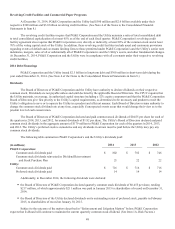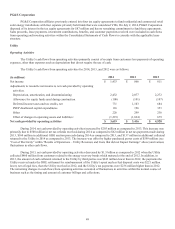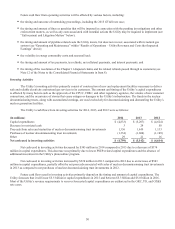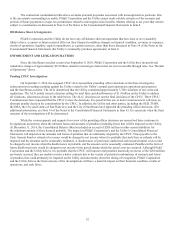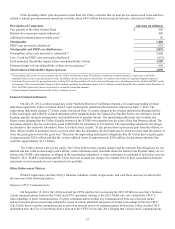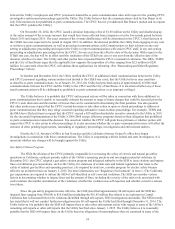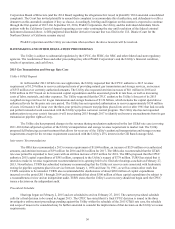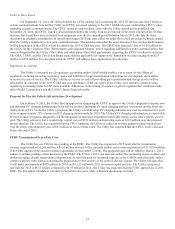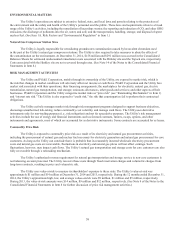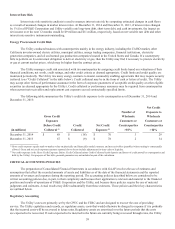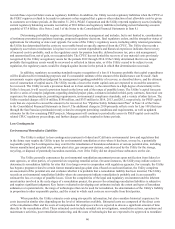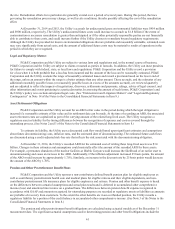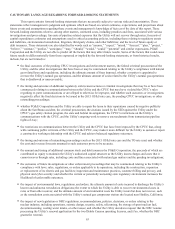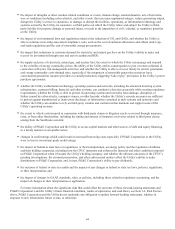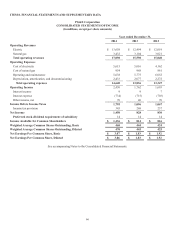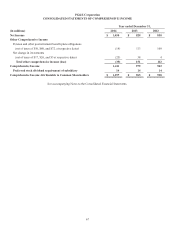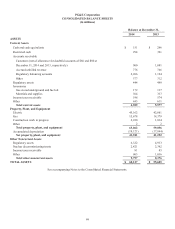PG&E 2014 Annual Report Download - page 66
Download and view the complete annual report
Please find page 66 of the 2014 PG&E annual report below. You can navigate through the pages in the report by either clicking on the pages listed below, or by using the keyword search tool below to find specific information within the annual report.58
ENVIRONMENTAL MATTERS
The Utility’s operations are subject to extensive federal, state, and local laws and permits relating to the protection of
the environment and the safety and health of the Utility’s personnel and the public. These laws and requirements relate to a broad
range of the Utility’s activities, including the remediation of hazardous wastes; the reporting and reduction of CO2 and other GHG
emissions; the discharge of pollutants into the air, water, and soil; and the transportation, handling, storage, and disposal of spent
nuclear fuel. (See Item 1A. Risk Factors and “Environmental Regulation” in Item 1.)
Natural Gas Compressor Station Sites
The Utility is legally responsible for remediating groundwater contamination caused by hexavalent chromium used
in the past at the Utility’s natural gas compressor stations. The Utility is also required to take measures to abate the effects of
the contamination on the environment. At December 31, 2014, $158 million and $291 million was accrued in the Consolidated
Balances Sheets for estimated undiscounted remediation costs associated with the Hinkley site and the Topock site, respectively.
Costs associated with the Hinkley site are not recovered through rates. (See Note 14 of the Notes to the Consolidated Financial
Statements in Item 8.)
RISK MANAGEMENT ACTIVITIES
The Utility and PG&E Corporation, mainly through its ownership of the Utility, are exposed to market risk, which is
the risk that changes in market conditions will adversely affect net income or cash flows. PG&E Corporation and the Utility face
market risk associated with their operations; their financing arrangements; the marketplace for electricity, natural gas, electric
transmission, natural gas transportation, and storage; emissions allowances, other goods and services; and other aspects of their
businesses. PG&E Corporation and the Utility categorize market risks as “price risk” (see “Ratemaking Mechanisms” in Item 1)
and “interest rate risk.” The Utility is also exposed to “credit risk,” the risk that counterparties fail to perform their contractual
obligations.
The Utility actively manages market risk through risk management programs designed to support business objectives,
discourage unauthorized risk-taking, reduce commodity cost volatility, and manage cash flows. The Utility uses derivative
instruments only for non-trading purposes (i.e., risk mitigation) and not for speculative purposes. The Utility’s risk management
activities include the use of energy and financial instruments such as forward contracts, futures, swaps, options, and other
instruments and agreements, most of which are accounted for as derivative instruments. Some contracts are accounted for as leases.
Commodity Price Risk
The Utility is exposed to commodity price risk as a result of its electricity and natural gas procurement activities,
including the procurement of natural gas and nuclear fuel necessary for electricity generation and natural gas procurement for core
customers. As long as the Utility can conclude that it is probable that its reasonably incurred wholesale electricity procurement
costs and natural gas costs are recoverable, fluctuations in electricity and natural gas prices will not affect earnings. Such
fluctuations, however, may impact cash flows. The Utility’s natural gas transportation and storage costs for core customers are also
fully recoverable through a ratemaking mechanism.
The Utility’s authorized revenue requirement for natural gas transportation and storage service to non-core customers is
not balancing account protected. The Utility recovers these costs through fixed reservation charges and volumetric charges from
long-term contracts, resulting in price and volumetric risk.
The Utility uses value-at-risk to measure its shareholders’ exposure to these risks. The Utility’s value-at-risk was
approximately $1 million and $14 million at December 31, 2014 and 2013, respectively. During the 12 months ended December 31,
2014, the Utility’s approximate high, low, and average values-at-risk were $9 million, $1 million and $5 million, respectively.
During 2013, the value-at-risk amounts were $14 million, $9 million and $12 million, respectively. (See Note 9 of the Notes to the
Consolidated Financial Statements in Item 8 for further discussion of price risk management activities.)


